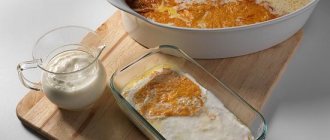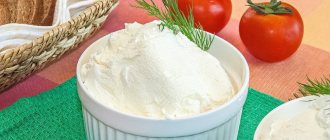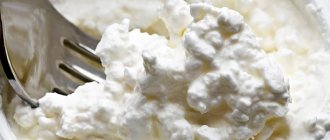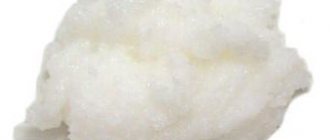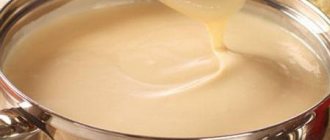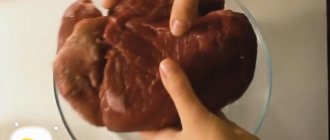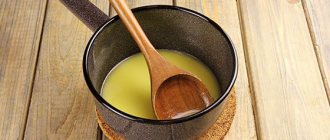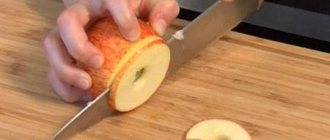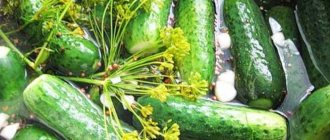Some have only heard about the Italian product, others have had the opportunity to try it, but few people actually know what it is. You can learn about all the intricacies of production only by making mozzarella cheese at home; production will not take more than an hour, but will give excellent results. From the cheese delicacy you can later prepare many hearty dishes, because the refined taste of the semi-solid product will decorate any of them.
It is difficult to completely replicate the original cheese recipe in the realities of our country, primarily due to the fact that in Italy (where the product originates) “Mozzarella” is prepared from buffalo milk.
It can hardly be found here, so homemade cheese, like industrial cheese, of Italian origin is made from cow’s or goat’s milk. But the cheese delicacy will not be tasteless or far from the original, since the elasticity of the consistency and the tenderness of the taste can be easily reproduced using just the right technology.
The history of mozzarella
For the first time in Italy, monks became interested in this product in search of the most suitable product for wine. It was then that buffalo milk was tested for cheese production. At the monastery of San Lorenzo, pilgrims were offered cheese and a loaf of bread. The monks called the cheese “mozza”.
A couple of centuries later, “mozza” was already sold in the rich markets of Naples. It was then that Bartolomeo Scappi mentioned a cheese called mozzarella in his cookbook.
Buffaloes are actively bred, and more and more mozzarella is produced for sale. And in the 18th century, the first cheese factory was built in the province of Caserta.
How to make mozzarella at home
Nothing is more synonymous with Italy than pizza, spaghetti and mozzarella cheese. But, if pizza and spaghetti are on everyone’s lips, then not everyone can say at least a couple of phrases about mozzarella. So who is he, this mysterious “Italian”?
- Origin story
- Recipe Ingredients Required
- Utensils and tools
- Cooking stages
Description and main types of mozzarella
Mozzarella can be distinguished from other cheeses by its appearance - these are medium-sized balls that float in brine. It is considered the most delicious one-day product, but to taste it, you will need to go to Italy.
There are several varieties of mozzarella - hard and smoked varieties.
Mozzarella cheese is layered in structure, has a delicate creamy taste, reminiscent of cottage cheese. Made according to a classic recipe from buffalo milk, it is saltier and fattier than those made from cow's milk.
Due to its soft structure, it is given different shapes, which is why it is called differently:
- Large balls are called bacconcini;
- Smaller balls - chiliegini;
- Small lumps the size of a pea - perlini;
- In the form of a braid - trechcha (it is also often smoked).
Homemade Mozzarella Cheese Recipe
History of creation
Mozzarella (Italian Mozzarella) is a young cheese originally from the Campania region, Italy. Classic Mozzarella is made from black buffalo milk, but more often it is made from cow's milk. This cheese belongs to the enzymatic coagulation cheeses and the Pasta Filata group. Most often these are white balls filled with brine.
About the recipe and starters
In 1570, the term “Mozzarella” itself appeared for the first time - in a cookbook written by the famous Bartolomeo Scappi, the court chef of the Pope. Our familiar Italian cheese makers told and showed the whole simple process of making Mozzarella at home. We, in turn, tried to select suitable starters and compiled step-by-step instructions so that you can learn how to prepare Mozzarella yourself.
Characteristics of the finished product
The taste of Mozzarella is tender, slightly fresh, slightly elastic. The outside of Mozzarella is smooth and shiny. The internal structure is slightly layered and does not contain air bubbles; whey is released when the cheese is cut. The shape and size of the cheese may vary:
“Bocconcini” – large balls “Cileggini” – balls the size of a large cherry “Perlini” – very small balls “Pigtail” – mozzarella is also made in the shape of a pigtail.
Materials and tools
An enamel saucepan or stainless steel bucket for 10-12 liters A bowl of water (water bath) for slowly heating the milk A plastic ladle A colander An electronic kitchen thermometer for food A slotted spoon A knife for cutting a curd or a cheese lyre Coarse salt, non-iodized
Raw materials and consumption rates
Milk: whole, ripened milk that has not undergone separation or heat treatment. From 10 liters of milk of medium fat content and medium protein content you will get about 1 - 1.2 kg of Mozzarella.
Operating procedure
For Mozzarella cheese, use whole ripened (kept at a temperature of +8 ° C...+12 ° C for 12-16 hours after milking) cow's milk. Pasteurization is recommended. Quickly heat the milk to +73 ° C with vigorous stirring, hold at +73 ° C for 30 seconds, quickly cool in a water bath to +32 ° C ... +34 ° C.
Add Mozzarella Sourdough (Str. Thermophilus) . Following the rules of asepsis and antiseptics, scatter the culture over the surface of the milk and leave for a while. After this, mix the milk thoroughly to evenly distribute the starter culture, leave for 30 minutes (for culture propagation).
A mandatory process is adding calcium!
food grade calcium chloride in 50 ml of boiled drinking water at room temperature and add to milk. Mix thoroughly.
Adding milk-clotting enzyme.
Important! The dose of milk-clotting enzyme may differ several times depending on the properties of the milk. We recommend that you always carry out a clotting test and calculate the dose of the enzyme individually for each specific case. You can find out more about this by following the link.
Pepsin-renin Meito is added at the rate of 0.04 - 0.14 g per 10 liters of milk (1 - 2 level measuring spoons ). First dissolve the enzyme in a tablespoon of boiled drinking water at room temperature. Add the enzyme solution to the milk and mix thoroughly*.
*stirring is carried out intensively, without creating flows circulating in a circle, evenly throughout the entire volume, for 5-7 seconds. Stop the flow of milk. In moving milk streams, the curd does not form correctly.
Checking clot formation and processing
The milk begins to curdle after 12-15 minutes, but it can take from 20 to 50 minutes for the curd to gain density and the desired acidity. You can find out more about this on the Zdoroveevo.rf website in the “Articles” .
Do not forget to maintain the temperature of the milk mixture around +32 ° C ... +34 ° C. Monitor the temperature with a thermometer. Clean separation of the curd from the whey must be achieved.
There are many verification methods. For example, you can place a slotted spoon on the surface of the clot - if rolled correctly, transparent whey will pass through its holes, and the clot, under the influence of the weight of the slotted spoon, will elastically bend a few millimeters. If this has not happened yet, leave the clot for a while longer.
Cut the curd with a knife or lyre vertically, and then horizontally into pieces with a side of 4-6 cm. The softer the cheese you want, the larger the size of the pieces. Leave for 5 minutes so that the cut curd thickens a little, settles, and the whey separates.
Second heating.
Next, heat the cheese mass for 20 minutes to +38 ° C with constant stirring. You need to stir throughout the entire volume from bottom to top, reaching to the bottom of the pan. Monitor the temperature of the cheese mass using a thermometer.
As a result of kneading, the so-called “closure” of the cheese grain occurs, which is necessary for the proper separation of the whey. The cheese grain will decrease in size, become elastic and sticky. When squeezed in your hand, the grain should stick together, and when rubbed between your palms, it should break up into individual grains.
Scoop out most of the whey. Place the cheese grain on a napkin in a colander, squeeze with your hands to compact the mass. Place the colander with the resulting mixture in a water bath. Maintain at a temperature of +38 ° C for 1.5...3 hours to achieve the desired acidity.
The achievement of the required acidity by the cheese mass is checked as early as possible - already 1.5 hours after placing the cheese grain in a colander. In this case, it is necessary to maintain the temperature of the cheese mass around +38 ° C to achieve the desired acidity*
* (for reference: 4.6 – 4.8 pH).
While the cheese mass is ripening, you can prepare a brine solution (for storing Mozzarella), the strength of which can vary from 10 to 18%. Heat part of the whey to +65 ° C...+75 ° C, dissolve the salt, cool to a temperature of +8 ° C... +12 ° C. Heat the remaining whey to +85 ° C... +90 ° C.
To determine the readiness of the cheese mass for melting and molding, a melting test is established.
Separate a small piece of the cheese mass, immerse it in hot whey at a temperature of +85 ° C...+90 ° C, wait a little and try to pull it out. This step is very important when preparing Mozzarella. If you rush and do not wait for this moment, the product will turn out to be hard and rubbery in taste. If you overdo it, the mass will fall apart. If the cheese stretches and does not tear, you can proceed to stretching. If the cheese does not pass the stretch test, leave it to “ripen”.
After a successful ripening test, we move on to the next stage - pulling the cheese.
Cut the compacted curd into long sticks. Since the serum is quite hot, you need to wear gloves. Immerse the cubes one by one into a container with hot (+85 ° C…+90 ° C) whey. Leave for a few seconds to soften. Place the heated mass on the table and stretch. Fold in half and stretch again. And so on several times. There are quite a few ways to pull. We recommend that you watch the video on the YouTube channel “How to cook Mozzarella” before cooking.
Then you can form balls from the cheese mass or braid braids from long strips. After this, place the formed Mozzarella in ice water to cool and fix the shape.
After some time, transfer the formed Mozzarella into the prepared brine for storage.
Conditions for ripening and storage of the finished product
It is recommended to store Mozzarella in the refrigerator in brine for no more than three to five days. In order to better experience its taste, it is also recommended to immerse the mozzarella in warm water (approximately +35 ° C) 5 minutes before consumption, after holding it for about half an hour at room temperature.
Tags: mozzarella, mozzarella recipe, cheese
The benefits of mozzarella for the body
Mozzarella cheese is good for the body because it is low in calories and contains only 20% fat. It is often used in dietary nutrition. It is rich in calcium and other beneficial substances. Recommended for children, elderly people and pregnant women.
The effect of this product on the body is manifested in the following beneficial properties:
- The potassium contained in cheese improves the functioning of the heart muscle;
- Calcium and phosphorus strengthen nails, teeth and bones;
- Sodium stabilizes water balance;
- Skin and vision are protected thanks to vitamin A;
- Cholesterol levels remain normal due to the choline present in the composition.
What is it - Mozzarella?
The cheese has a pleasant mild taste and looks very aesthetically pleasing. The product has many useful properties. The shape of the cheese may vary. For example, there are prepackaged pea-sized mini balls that are sold in brine. A ball of such cheese must have an outer surface thickness of at least 1 mm. The product has a layered structure; if the ball is cut, the whey comes out. Hard smoked Mozzarella is also quite often found on store shelves.
In Italy, the product is used everywhere in a variety of dishes. For example, everyone’s favorite calzone cannot be made without Mozzarella. Caprese salad is a famous dish in Russia. In it, Mozzarella harmonizes perfectly with tomatoes and herbs. It is noteworthy that the color of the salad is very similar to the colors of the national flag of Italy.
Description
The product is unsalted. The technology for its preparation has existed for hundreds of years. The classic version of Mozzarella is made from black buffalo milk with the addition of a special starter made from the gastric juice of a young (no more than 6 months) calf. The contents are then heated, thereby generating a coagulation process. The resulting composition is left for 9 hours. After this, the composition is heated again and mixed until a thick, dense mass is obtained. Balls or “braids” are formed from it. They are immediately placed in ice water, to which salt is added. After this, the product is packaged and sent to trading floors.
Real Mozzarella can only be found on the Apennine Peninsula. In other parts of the world, the product is made from goat's or cow's milk with special additives. During production, the cheese acquires the thickness of cottage cheese. It is then melted, which makes it very soft. In some cases, skim milk is used to produce the product. Typically this cheese is used to make pizza.
Compound
Cheese contains a huge amount of riboflavin (B2). This is a powerful antioxidant that stimulates the functioning of the brain and spinal cord, which is a preventative against dementia. Niacinth (B3) is also present in fairly large quantities in Mozzarella. It transforms fats into energy, prevents diabetes and arthritis, and normalizes the amount of bad cholesterol in the body. We must also not forget about such useful vitamins as A, E and D.
Mozzarella is very nutritious. The calorie content of the product is 245 kcal. Moreover, in cheese:
- protein – 19 g;
- fat – 24 g;
- carbohydrates – 0 g.
It also contains a variety of microelements beneficial to the body. There are Omega 3 acids, which are found in fish oil, and a huge amount of amino acids. In addition, Mozzarella contains a unique beneficial element biotin (B7), which the human body cannot synthesize. Biotin optimizes metabolism, reduces sugar levels, strengthens the walls of blood vessels, as well as hair and nails.
Types of cheese vary in size and shape:
- Techcha is made in a configuration that resembles a woman's braid;
- Perlin is a cheese that looks like pea balls;
- Ciliegini is produced in balls the size of cherries;
- Bocconcini is Mozzarella the size of a billiard ball.
Equipment for making mozzarella at home
To prepare at home you will need the following equipment:
- Dishes for heating milk (not aluminum);
- A special square or round mold for cheese with holes (for liquid drainage);
- Thermometer, preferably electronic;
- A heavy object used as a press;
- Sterile gauze.
Article on the topic: How to cook delicious nuggets in the microwave
Mozzarella recipe
| Ingredients | Quantity |
| Milk - | 2 l |
| Distilled water - | 250 g |
| Lemon acid - | ½ teaspoon |
| Rennet - | 2 teaspoons |
| Salt - | taste |
| Cooking time: 75 minutes | Calorie content per 100 grams: 89 Kcal |
Before you start making cheese, you need to dissolve citric acid in ½ part of the volume of cold water. Rennet is also mixed with water.
The milk needs to be warmed up a little, to 17-18 degrees, add a solution of citric acid to it, stirring the liquid constantly. Then place on low heat and bring the temperature of the composition to 36 degrees.
Now it’s the turn of the rennet composition; it is also mixed with heated milk and stirred for three minutes.
After which the fire can be extinguished, the container can be covered and left for forty minutes to form a clot that does not stick to your hands.
You need to put on gloves, remove the resulting mass from the container and put it in a colander. Bring the liquid that remains in the pan to a boil and add salt.
Then the cheese is dipped into hot salted liquid for a few seconds, after which you can try to stretch the cheese mass in your hands. Good elasticity should be present; if the clot does not break, it means the process was correct.
The mass needs to be kept in the liquid for some time, while trying to knead it better. This will give it uniformity and ductility.
Now the mozzarella cheese is ready. The next step is to choose a mold for the cheese. You can form balls of any size or strip and serve.
Another recipe for making mozzarella at home
Required:
- 1.5 liters of cow's milk;
- 250 ml of high quality purified water;
- Rennet – pepsin – 2 teaspoons;
- Half a teaspoon of citric acid;
- Table salt – 1 teaspoon.
We take half the volume of cold water for a solution with citric acid.
Pour the milk into a saucepan, do not heat it, but immediately add the acidic solution. Bring the liquid to a temperature of 30 degrees, pour in the pepsin diluted in the remaining cold water. Mix well, remove from heat and leave for half an hour. After this time, we look into the pan - a mass similar to cottage cheese has formed there.
This mass needs to be cut into several small pieces. Once again we heat the container, the temperature should not exceed 35 degrees. Stir the mixture constantly.
Remove from heat, strain into a colander and squeeze lightly. We bring the water to a temperature of 90 degrees, add the cheese mass into it, and in five minutes the homemade mozzarella is ready. We put on rubber gloves so as not to burn our hands, knead the cheese into a ball and place it in cold water.
Making mozzarella at home: the final stage
Remove the cottage cheese from the hot water. At the same time, check whether it stretches, since its consistency should be sticky and homogeneous. If the cottage cheese crumbles, check whether the water in the pan is hot enough. If necessary, heat it and keep the curd mass in it for some more time. Stretch and fold your almost finished cheese several times. When you are sure that it has acquired the required consistency, roll it into a ball.
Now you can proceed to preparing the brine. To do this, mix two glasses of whey with two tablespoons of salt. Add a few ice cubes there. You need to put the finished cheese into the resulting brine. It should remain there until it cools. The finished mozzarella can then be removed from the brine.
To properly store cheese, it must be wrapped in cling film and then sealed in an airtight container. Thus, you can keep it in the refrigerator for a week, and in the freezer for a month.
Useful tips and tricks
- Before preparing mozzarella at home, you must thoroughly rinse all containers and rinse them with boiling water. This will help avoid the proliferation of foreign microorganisms in milk and cheese;
- According to the recipe, the milk requires heating, it is better to do this in a water bath, so it warms up evenly;
- The fat content of milk should be medium. Any kind will do - whole, pasteurized and even dry. But the taste of cheese directly depends on the quality of the dairy product, so it is better not to save money and use fresh whole milk;
- The water in which rennet and bacteria (or citric acid) are dissolved must be clean, preferably distilled, not too cold, preferably at room temperature. The brine in which the mozzarella is placed should, on the contrary, be very cold, the colder the better;
- To increase the moisture content of mozzarella, you need to use a mixture of thermophilic bacteria instead of citric acid. Then it will turn out very soft and moist;
- When preparing mozzarella, the stage where the cheese must stretch well is important. If you rush and do not wait for this moment, the product will turn out to be hard and rubbery in taste. If you overdo it, the mass will fall apart;
- After preparing the mozzarella, it is placed in brine and put in the refrigerator. The longer it sits in the liquid, the saltier it will be;
- Before use, the cheese must be removed from the brine and dried with a towel.
Article on the topic: Ayran - benefits, harms and rules for choosing a drink
Some tips
— If you decide to make mozzarella cheese at home, then before you begin this process, make sure that all kitchen utensils and utensils are clean. After all, fresh cheese spoils very quickly if it is exposed to bacteria.
— If fresh mozzarella is too soft to grate, you can first freeze it.
— The whey left over from making mozzarella can be used to make ricotta cheese.
Features of storage and serving
Mozzarella cheese cannot be stored for long periods of time and is eaten immediately after preparation. But if you keep it in salty brine for a while, it will taste more piquant. It is permissible to keep it in this brine for no more than three days. If the cheese has acquired a sour or bitter taste, it means that it has spoiled and is no longer suitable for food. If this type of cheese is left without brine, the product will become dry and lose its delicate taste.
The brine is quite easy to prepare:
- Liter of whey;
- 4 tablespoons salt;
- Stir until the salt is completely dissolved.
Mozzarella cheese must be stored by placing it in brine and refrigerating it.
Served as a separate dish as an appetizer or as part of other dishes. Mozzarella cheese goes well with tomatoes and basil in the traditional Italian dish Caprese, and also goes well with white wine. Mozzarella is often consumed as a dessert with fruit and sweet wines.
In Italy, cheese is used in most recipes. Mozzarella will be good in making pasta, lasagna and pizza. This delicate product will add sophistication to your dishes.
Salad with mozzarella and arugula
You can surprise your guests by offering them this salad as an appetizer. It will require the following ingredients:
- 200 grams of mozzarella;
- Arugula - 60 grams;
- Two fresh tomatoes (you can use cherry tomatoes);
- Basil;
- Olive oil - 30 grams;
- Thyme, spices to taste;
- Balsamic vinegar;
- 2 cloves of garlic.
To prepare the sauce, mix olive oil, basil, thyme, garlic and spices. Cut the cheese into thin slices, tomatoes into rings, place arugula on top, pour over the sauce. In addition, shrimp, olives, and mushrooms are often used. The components can be alternated at your discretion.
The tender and light salad is ready. Bon appetit!
Making mozzarella at home is a simple process, and the pleasant, delicate taste of this cheese will certainly delight you and serve as a reward for your efforts.
Cooking at home
So, how to make tender and tasty mozzarella cheese at home? Here's what you'll need for this:
- 4 liters of milk (it is better to take fatty, rustic, but from a proven cow);
- 1.5 teaspoons of citric acid;
- 175 ml water;
- rennet (it is better to buy it at the pharmacy; be sure to read the instructions before use).
Now the cooking instructions:
- So, first, dilute citric acid in water. This component is needed to give the cheese the desired consistency. The water should be cold, preferably boiled, since bleach can kill some components of the acid, then you won’t succeed. So, stir the required amount of acid in 125 ml of water until completely dissolved.
- Now take the remaining water (50 milliliters left) and dissolve the enzyme in it. The exact amount will be indicated on the package, but only a small amount will be needed, about a small pinch. Stir the powder until dissolved.
- Pour the milk into the pan, it should not be hot, the maximum temperature is 17 degrees, if this value is exceeded, the milk will immediately curdle when acid is added, which is not required yet.
- Start gradually pouring the citric acid solution into the milk. Pour it in a thin stream, stir the milk constantly.
- Now place the pan on the stove, the heat should be low. It is better to take a special thermometer to control the temperature. You need to heat the milk to 35-38 degrees, no more.
- Pour the enzyme dissolved in water into the heated milk and mix everything well. Stir everything for 2-3 minutes. The fire should be minimal, and then (after 3 minutes) it can be turned off.
- Cover the pan with a lid and wait about 30-40 minutes. The process of folding must begin. You will form a kind of clot. In this case, the mass should not stick to your fingers.
- Catch the clot using a colander or slotted spoon, shake off excess liquid.
- Heat the resulting whey (what is left after folding) to approximately 85-90 degrees. Pour some of it (about a glass) and add salt (to taste). You will store the finished cheese in this composition.
- Dip the cheese into the heated whey. Wear thick gloves to avoid burning your hands. After about 10-20 seconds, take out the clot, remember it, and stretch it. It shouldn't break. Then dip the cheese into the whey again, then stretch and knead again. Repeat this until the mass becomes viscous, smooth and tender.
- Cut the finished mozzarella into balls or strips. Ready!
If desired, when kneading and stretching, you can add spices or even pieces of olives (and some add ham) to make the taste more unusual.
Easy and quick recipe for making homemade mozzarella
Mozzarella is a rennet cheese. To prepare it you will need rennin. The process is not similar to making cottage cheese, and in this case it is worth purchasing a kitchen thermometer, since the temperature regime must be strictly observed. The yield of the finished product is less - about 10-12% of the initial amount of milk.
To get 500-600 grams of mozzarella you will need:
- 5 liters of milk;
- rennin, diluted in 50 ml of drinking bottled water (available in tablets and liquid form; the amount depends on the manufacturer, read the instructions on the package);
- 1.5 tsp. citric acid diluted in 100 ml of clean drinking water;
- 4 tbsp. l. salt;
- 4 liters of cold drinking water;
- 4 liters of hot water;
- a few ice cubes.
to contents ^
Heat
Pour milk into a saucepan and place on low heat. Pour in diluted citric acid. Stir constantly with a large slotted spoon, lower the thermometer into the pan, and heat to 32 °C.
Adding Enzyme
When the temperature reaches 32 °C, remove the pan from the heat and pour in the diluted rennin. Stir for a minute.
Clot formation
Cover the pan with a lid and leave it warm for 5-10 minutes. You can put it on the stove, but be sure to ensure that the temperature of the milk does not exceed 32-33 °C. After the specified time, a large clot forms in the pan, clearly separated from the whey.
Kneading and heating
Using a knife, cut the curd into squares with sides about 20 mm across the entire depth of the pan. Place the pan on low heat. Stir the squares constantly with a wooden spoon or spatula. The mass should be slowly heated to 41 °C, the heating process lasts at least 10 minutes.
Whey separation
When the temperature reaches 41°C, remove the pan from the heat and continue stirring for one to two minutes. Then transfer the curd using a large slotted spoon into a colander with small round holes and squeeze out the whey, turning and pressing on the curd. The goal is to remove the maximum amount of liquid.
If the curd is too large, divide it into 2 parts and do this and the following steps for both.
to contents ^

